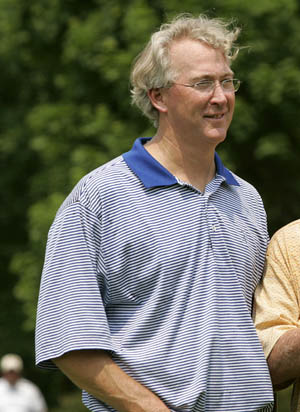
Chesapeake Energy CEO Aubrey McClendon during the Morgan Stanley Pro-Am Invitational at The Memorial Tournament in 2007.
Hunter Martin / Getty Images


Chesapeake Energy CEO Aubrey McClendon during the Morgan Stanley Pro-Am Invitational at The Memorial Tournament in 2007.
Hunter Martin / Getty Images

Hunter Martin / Getty Images
Chesapeake Energy CEO Aubrey McClendon during the Morgan Stanley Pro-Am Invitational at The Memorial Tournament in 2007.
The line between Chesapeake Energy and Aubrey McClendon is blurry. But shareholders likely don’t realize how intertwined the finances of the publicly traded company and its CEO actually are, a new Reuters investigation reveals.
The enmeshment is so deep, the Oklahoma City company has set up a unit — AKM Operations — in an annex office to help McClendon with his personal projects.
The personal business unit, executive jet flights and the Oklahoma City Thunder are all part of McClendon’s “lavish” lifestyle, Reuters reports.
And, according to the news service’s investigation, a lot of that lifestyle is leveraged.
McClendon’s contract affords him the use of Chesapeake facilities for personal businesses and investment activities. He’s required to reimburse the company for employees who primarily work on his personal business, but he doesn’t have to pay for secretarial and administrative support.
But the scope and sophistication of the support, including AKM Operations, is not broken out in public disclosures, John Shiffman, Anna Driver and Brian Grow with Reuters report.
A Chesapeake accountant, for example, helped McClendon put a ranch up for auction. The same accountant also coordinated the repair of a hail-damaged home McClendon was buying, and administrates several websites for the CEO’s personal projects, Reuters reports.

Tomfs / Flickr
The Chesapeake Boathouse overlooks the Oklahoma River in downtown Oklahoma City. The boathouse has helped transform the river into an Olympic-class rowing venue.
Finding out where Chesapeake’s finances end and McClendon’s begin is difficult, Reuters reports, and the company spends millions on projects that McClendon is personally passionate about.
McClendon co-owns the Deep Fork restaurant, which earns hundreds of thousands of dollars catering Chesapeake events. Another restaurant he has a stake in, Metro Wine Bar & Bistro, operates out of a building owned by a Chesapeake subsidiary, the news service reports.
McClendon also owns a 19 percent stake of the Oklahoma City Thunder, which has a $36 million sponsorship deal with Chesapeake.
And much of what McClendon owns is mortgaged — including part of his Thunder stake, Reuters reports.
What hasn’t been previously disclosed is that McClendon mortgaged his future proceeds from the team to secure two bank loans.
… twice, McClendon has pledged his share of future proceeds from the Thunder as collateral for loans, from Bank of America in 2009 and Wells Fargo in 2010, according to records reviewed by Reuters. Neither loan has been previously disclosed.
Further particulars of the Thunder loans — the amount McClendon borrowed, whether they have been repaid or whether the NBA or his Thunder partners were notified — could not be determined.
Other McClendon passions parallel company spending, Reuters reports:
In many ways McClendon still runs the company like he did when he co-founded it, Reuters reports. The company started with 10 employees in 1989, but Chesapeake is now a Fortune 500 company with more than 13,000 employees.
It has grown so big and McClendon has sold so much stock — dumping $569 million during a personal financial crisis in 2008 — that he now owns less than 1 percent of the company.